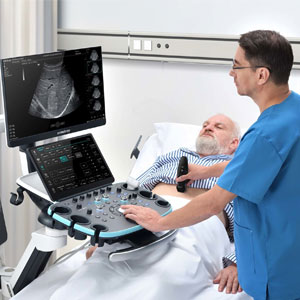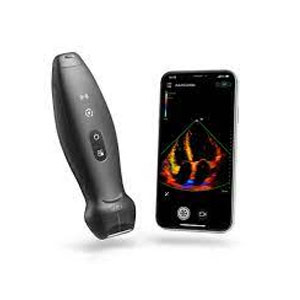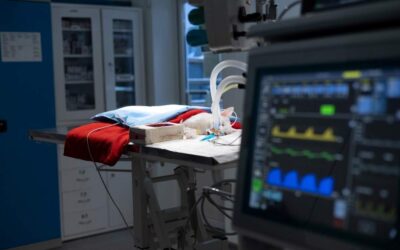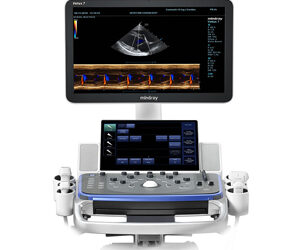Updated 1/8/2025
In recent years, portable ultrasound machines have become indispensable tools for a variety of medical specialties, from cardiology to emergency care. As technology advances, selecting the right machine for your practice can be challenging but essential for delivering high-quality patient care.
Why Go Portable?
The portability of ultrasound machines offers several distinct advantages, particularly in settings that demand quick, accurate diagnostics. Portable devices allow for point-of-care ultrasound (POCUS), enabling clinicians to perform real-time imaging in a variety of environments, from operating rooms to remote, underserved areas.
Enhanced Patient Care
Portable machines reduce the need for patients to be transported to imaging rooms, thus improving comfort and streamlining workflow. In high-pressure environments such as emergency rooms or disaster relief settings, portability allows for faster diagnostics and treatment initiation, which can be life-saving.
Cost Efficiency
For smaller practices, clinics, and healthcare providers on a budget, portable ultrasound machines offer a cost-effective solution. These devices typically have lower initial costs compared to traditional cart-based systems, and the reduced need for infrastructure and specialized rooms adds to their financial appeal.
Many of today’s machines also have a lower total cost of ownership, which includes reduced maintenance, repair, and software upgrade expenses.
Key Considerations When Choosing a Portable Ultrasound Machine
With various models on the market, selecting the right machine depends on several critical factors. These include the types of imaging required, your budget, and the machine’s ease of use and integration into your practice.
Imaging Quality
The cornerstone of any ultrasound machine is its image quality. Modern portable ultrasound systems offer high-resolution imaging, which is crucial for accurate diagnostics. Advances in technology, such as AI-powered imaging and enhanced transducers, mean that portable machines now offer quality that rivals some traditional models. For example, the Mindray TE Air features advanced imaging powered by Single Crystal technology, while the Butterfly iQ3 provides multi-mode scanning with AI enhancements, making them highly versatile for different clinical applications.
Portability and Usability
One of the main reasons to choose a portable system is its ease of use. Look for machines that offer intuitive interfaces, such as touch screens and pre-configured settings, which can save time during critical procedures. Wireless devices, like the Vscan Air SL, further enhance portability by allowing clinicians to conduct scans from anywhere without the hassle of cumbersome cables.
Ergonomic considerations also play a role; machines that offer adjustable height and swivel monitors can help reduce strain for operators.
Related: Mindray TE AIR Ultrasound
Probes and Transducers
The types of probes your practice requires depend on the specific imaging tasks you perform. For instance, cardiology clinics typically use phased array probes for cardiac assessments, while OB/GYN practices may need curvilinear or transvaginal probes for fetal imaging and gynecological exams.
Some machines, like the Clarius HD3, offer dual-probe designs that allow both shallow and deep scanning, reducing the need to switch probes during examinations.
Workflow Integration
 Modern portable ultrasound machines come with features that can streamline your workflow, saving time and reducing errors. AI-driven automation, such as auto-measurement tools and image optimization, is becoming increasingly common. These features can be particularly beneficial for practices that handle a high volume of scans, as they improve consistency and reduce operator fatigue.
Modern portable ultrasound machines come with features that can streamline your workflow, saving time and reducing errors. AI-driven automation, such as auto-measurement tools and image optimization, is becoming increasingly common. These features can be particularly beneficial for practices that handle a high volume of scans, as they improve consistency and reduce operator fatigue.
Many machines also offer cloud integration and wireless connectivity, allowing for seamless data sharing between devices. This is particularly useful for multi-room practices or when images need to be reviewed by a specialist remotely. Systems like the Butterfly iQ3 are capable of connecting to electronic medical records (EMR) and PACS systems, ensuring a streamlined flow of data.
Battery Life and Portability
When considering a portable device, battery life is an essential factor. Some machines, such as the GE Vivid iq, offer extended battery life of up to three hours, allowing for uninterrupted use in busy clinical environments.
Quick-charging features and long-lasting batteries are key for settings like emergency rooms, where every minute counts.
Budget and Total Cost of Ownership
Prices for portable ultrasound machines can vary significantly depending on the brand, features, and intended use. Entry-level machines may cost as little as $5,000, while high-end models with advanced imaging capabilities can reach up to $40,000.
However, it’s important to consider the total cost of ownership, including maintenance, software updates, and consumables. Some models, like the Philips CX50, justify their higher price with features such as xMatrix and PureWave technologies, which enhance diagnostic capabilities across a range of specialties.
Future-Proofing with AI and Advanced Features
One of the most exciting developments in the field of portable ultrasound is the integration of artificial intelligence. AI helps automate tasks like image analysis and anomaly detection, making it easier for less experienced operators to deliver accurate diagnoses. As this technology continues to evolve, we can expect even greater improvements in both diagnostic accuracy and workflow efficiency.
For example, AI-assisted systems like the Butterfly iQ3 and Mindray TE Air simplify complex procedures by offering features such as beam steering and tissue harmonic imaging.
These machines are not only more accessible but also help improve patient outcomes by reducing the time it takes to interpret scans.
Integration of Telemedicine and Remote Diagnostics
The use of portable ultrasound machines is expanding rapidly in telemedicine. This integration allows specialists to perform real-time diagnostic imaging remotely, especially in rural or underserved areas. Portable machines equipped with wireless connectivity enable clinicians to capture high-quality images and send them instantly to specialists for review. This method enhances patient care by facilitating faster diagnosis and treatment without the need for patient travel, which is particularly useful in global health initiatives and emergency response scenarios. Additionally, the use of telemedicine in conjunction with portable ultrasound is increasingly becoming a trend as healthcare systems seek to extend their reach while reducing costs.
In particular, portable devices such as the Clarius HD3 and Mindray TE Air are designed with wireless features, making them ideal for telemedicine settings. They allow remote specialists to guide on-site healthcare providers during ultrasound exams, ensuring accurate data collection and interpretation. As telemedicine continues to grow, portable ultrasound machines will play a pivotal role in expanding access to high-quality diagnostic tools.
Enhanced Applications for Point-of-Care Ultrasound (POCUS)
Point-of-care ultrasound (POCUS) is one of the most significant developments in portable ultrasound technology. POCUS is particularly useful in critical care, emergency medicine, and general practice, where quick, real-time diagnostics are essential. With the increasing adoption of POCUS, clinicians can perform a variety of diagnostic and therapeutic procedures right at the bedside, avoiding delays that may occur when transferring patients to dedicated imaging departments.
Portable machines such as the Mindray TE Air and Butterfly iQ3 are optimized for POCUS applications and offer advanced imaging capabilities that can be utilized in cardiac, pulmonary, abdominal, and musculoskeletal assessments. In emergency settings, portable ultrasound allows for the rapid assessment of conditions like internal bleeding, pericardial effusion, or pneumothorax. As training programs for POCUS expand globally, more healthcare providers are incorporating it into their practices, making portable ultrasound an essential tool for immediate patient care.
Related: Mindray M9 Ultrasound System
Advancements in 3D and 4D Imaging
The evolution of ultrasound imaging has seen significant advancements, especially with the advent of 3D and 4D technologies. Three-dimensional (3D) imaging provides detailed anatomical views, while 4D imaging adds the element of real-time motion, allowing clinicians to observe dynamic physiological processes. These advancements are particularly beneficial in fields like obstetrics, where clinicians can monitor fetal development with unparalleled clarity and detail.
Portable machines equipped with 3D and 4D capabilities are becoming more common, enabling clinicians to conduct highly detailed assessments outside of traditional imaging centers. The Philips CX50, for example, offers 4D cardiac imaging, allowing for a more comprehensive analysis of heart structures and functions. As these technologies become more accessible in portable formats, they provide greater diagnostic accuracy across a range of specialties, including orthopedics, cardiology, and OB/GYN.
The Importance of Ergonomics in Ultrasound Use
Given the hands-on nature of ultrasound exams, operator fatigue is a significant concern, particularly in high-volume practices. Ergonomically designed ultrasound machines reduce the physical strain on operators, improving comfort and preventing repetitive strain injuries (RSIs) that are common in sonographers and technicians. Features like adjustable monitors, lightweight probes, and customizable control panels are essential for long-term use without causing physical discomfort.
Portable ultrasound systems such as the GE Vivid iq and Siemens Acuson P500 are designed with ergonomics in mind. These devices feature swivel monitors, customizable height settings, and easy-to-hold probes that reduce the physical toll on operators during lengthy procedures. Ergonomic designs also promote efficiency by allowing users to perform scans faster, with fewer errors. As more clinics invest in ergonomic ultrasound systems, they can expect reduced downtime due to operator fatigue, ultimately boosting productivity and patient care quality.
Doppler Imaging and Its Uses in Portable Ultrasound
Doppler ultrasound is a critical feature in many modern portable machines, used primarily to evaluate blood flow through vessels and the heart. It works by measuring the change in frequency of sound waves as they bounce off moving objects, such as red blood cells. This allows clinicians to visualize and assess blood flow, diagnose blockages, or detect abnormal circulation patterns.
Portable systems like the GE Vivid iq and Philips CX50 are equipped with multiple types of Doppler imaging—Color Doppler, Power Doppler, and Pulsed-Wave Doppler—each providing distinct benefits. For instance, Color Doppler allows for visualizing the speed and direction of blood flow, while Power Doppler provides better sensitivity for detecting low-velocity blood flow in smaller vessels. These Doppler functions are essential in fields such as cardiology, vascular surgery, and obstetrics.
Transducer Technology: The Heart of Ultrasound Imaging
The transducer, or probe, is one of the most critical components of an ultrasound system, converting electrical signals into sound waves and then receiving echoes back to create images. Various types of transducers serve different purposes, such as linear, convex, phased array, and 3D probes.
In portable machines, the technology behind transducers has advanced significantly. High-frequency transducers are ideal for superficial imaging, like vascular or musculoskeletal assessments, while lower-frequency transducers are used for deeper structures like abdominal organs. Devices such as the Mindray TE Air and Butterfly iQ3 offer versatile transducer options, some even with dual-probe designs to switch between shallow and deep imaging without changing devices.
Additionally, single crystal transducer technology, found in high-end systems like the Philips CX50, enhances imaging depth and resolution by using more uniform piezoelectric crystals, which produce stronger and more consistent sound waves. This technology is particularly useful in challenging diagnostic scenarios, such as imaging obese patients or identifying subtle tissue abnormalities.
Ultrasound Modes: B-mode, M-mode, and Advanced Imaging Techniques
Portable ultrasound machines now offer multiple imaging modes to accommodate a variety of diagnostic needs. The most common mode, B-mode (Brightness mode), creates a two-dimensional image and is the default for general diagnostics. M-mode (Motion mode), on the other hand, captures moving structures, making it essential for cardiac and fetal heart monitoring. Both of these modes are standard features on nearly all portable ultrasound devices.
In addition to B-mode and M-mode, advanced imaging techniques have made their way into portable systems. For example, Tissue Harmonic Imaging (THI), available in devices like the Butterfly iQ3, improves image quality by using higher harmonic frequencies generated within the tissue itself, reducing noise and providing clearer images. Advanced Doppler modes such as Pulsed-Wave Doppler and Continuous-Wave Doppler, found in the GE Vivid iq, allow for detailed flow measurements, critical in assessing heart valves or arterial disease.
Battery Life and Power Management in Portable Ultrasound Systems
Battery life is a key factor in portable ultrasound systems, particularly for mobile applications where access to a power source may be limited. Most modern portable ultrasound machines offer substantial battery life, ranging from 40 minutes to several hours, depending on the model. Devices like the GE Vivid iq provide up to three hours of operation, while the Mindray TE Air features rapid charging and extended battery life to minimize downtime.
Power management systems have also improved, allowing machines to enter low-power modes when not in use or offering quick-charge capabilities for fast deployment. These advancements make portable ultrasound machines highly reliable in emergency settings or rural healthcare, where the ability to perform continuous imaging is crucial.
Needle Visualization for Precision Procedures
One of the most valuable features in modern ultrasound machines, particularly in point-of-care settings, is needle visualization. This feature enhances the ability to guide needles during invasive procedures such as biopsies, fluid drainage, or the placement of central lines. By providing real-time feedback on the needle’s position relative to surrounding structures, needle visualization reduces the risk of complications and increases the success rate of the procedures.
Machines like the Siemens Acuson P500 and the Philips CX50 are equipped with advanced needle visualization technology, often using a combination of B-mode imaging and Doppler to clearly differentiate the needle from surrounding tissue. This is especially important in emergency or critical care settings, where precision is paramount.
Data Management and Connectivity in Portable Ultrasound
In today’s healthcare environment, the ability to quickly and securely share patient data is critical. Many portable ultrasound machines now offer advanced data management capabilities, including wireless connectivity to EMR (Electronic Medical Record) systems, cloud storage, and PACS (Picture Archiving and Communication Systems) integration.
For instance, devices like the Butterfly iQ3 and Clarius HD3 allow for immediate transmission of images and reports to a centralized database, ensuring that diagnostic data is readily available to other healthcare professionals. These systems also feature robust data encryption to maintain patient confidentiality, a key consideration in modern medical practices. Furthermore, the ability to store, retrieve, and analyze data remotely enhances collaboration and speeds up the decision-making process.
Making the Right Choice for Your Portable Ultrasound Machine
Choosing the right portable ultrasound machine for your practice is a critical decision that impacts diagnostic capabilities, workflow efficiency, and patient outcomes. By considering essential factors such as image quality, transducer options, workflow integration, and technological advancements like AI and Doppler imaging, you can select a machine that best suits your clinical needs. Additionally, ergonomics, battery life, and data management capabilities play vital roles in ensuring long-term usability and seamless integration into your practice.
As the market for portable ultrasound devices continues to grow, keeping up with trends like AI integration, enhanced POCUS capabilities, and 3D/4D imaging will help future-proof your investment. Whether you are a general practitioner, a specialist, or a healthcare provider working in remote areas, the right machine will provide significant improvements in patient care and operational efficiency.














